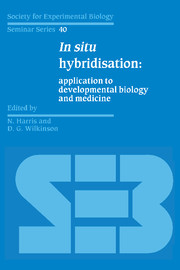Book contents
- Frontmatter
- Contents
- List of contributors
- Preface
- Non-radioisotopic labels for in situ hybridisation histochemistry: a histochemist's view.
- Use of haptenised nucleic acid probes in fluorescent in situ hybridisation
- The use of complementary RNA probes for the identification and localisation of peptide messenger RNA in the diffuse neuroendocrine system
- Contributions of the spatial analysis of gene expression to the study of sea urchin development
- Advantages and limitations of in situ hybridisation as exemplified by the molecular genetic analysis of Drosophila development
- The use of in situ hybridisation to study the localisation of maternal mRNAs during Xenopus oogenesis
- In situ hybridisation in the analysis of genes with potential roles in mouse embryogenesis
- Evolution of algal plastids from eukaryotic endosymbionts
- Localisation of expression of male flower-specific genes from maize by in situ hybridisation
- Tissue preparation techniques for in situ hybridisation studies of storage-protein gene expression during pea seed development
- Investigation of gene expression during plant gametogenesis by in situ hybridisation
- Sexing the human conceptus by in situ hybridisation
- Non-isotopic in situ hybridisation in human pathology
- The demonstration of viral DNA in human tissues by in situ DNA hybridisation
- Index
Sexing the human conceptus by in situ hybridisation
Published online by Cambridge University Press: 04 August 2010
- Frontmatter
- Contents
- List of contributors
- Preface
- Non-radioisotopic labels for in situ hybridisation histochemistry: a histochemist's view.
- Use of haptenised nucleic acid probes in fluorescent in situ hybridisation
- The use of complementary RNA probes for the identification and localisation of peptide messenger RNA in the diffuse neuroendocrine system
- Contributions of the spatial analysis of gene expression to the study of sea urchin development
- Advantages and limitations of in situ hybridisation as exemplified by the molecular genetic analysis of Drosophila development
- The use of in situ hybridisation to study the localisation of maternal mRNAs during Xenopus oogenesis
- In situ hybridisation in the analysis of genes with potential roles in mouse embryogenesis
- Evolution of algal plastids from eukaryotic endosymbionts
- Localisation of expression of male flower-specific genes from maize by in situ hybridisation
- Tissue preparation techniques for in situ hybridisation studies of storage-protein gene expression during pea seed development
- Investigation of gene expression during plant gametogenesis by in situ hybridisation
- Sexing the human conceptus by in situ hybridisation
- Non-isotopic in situ hybridisation in human pathology
- The demonstration of viral DNA in human tissues by in situ DNA hybridisation
- Index
Summary
Introduction
DNA-DNA in situ hybridisation is widely used by geneticists as a tool for mapping genes on chromosomes. More recently, the development of chromosome-specific probes has enabled in situ hybridisation to be used to detect the presence of specific chromosomes in interphase nuclei and to determine the number of copies of chromosomes present. This has been applied to clinical prenatal diagnosis of human genetic diseases that involve numerical chromosome aberrations and in cases where only boys are at risk for X-linked disorders. This approach has also been useful as an experimental tool for detecting polyploid interphase nuclei. My own work in this field has been confined to in situ hybridisation with a Y chromosome DNA probe to sex the human fetus and pre-embryo. These studies illustrate the possibilities of using DNA-DNA in situ hybridisation both for prenatal or preimplantation diagnosis and for experimental investigations of ploidy.
Prenatal diagnosis
At present, samples of cells for prenatal diagnosis may be obtained by amniocentesis, chorionic villus sampling or fetal blood sampling. In the future it may also be possible to sample cells of a preimplantation stage embryo (or pre-embryo) for genetic tests before the pre-embryo is returned to the uterus to continue development. This possibility of preimplantation diagnosis is discussed in a later section.
Amniocentesis involves the aspiration of 10–20 ml of amniotic fluid at 16–20 weeks gestation. At 18–19 weeks, 20 ml of amniotic fluid contains about 1 million cells (Gosden & Gosden, 1985) of heterogeneous origin and yields approximately 7 µg of DNA (Old, 1986).
- Type
- Chapter
- Information
- In Situ HybridisationApplication to Developmental Biology and Medicine, pp. 205 - 240Publisher: Cambridge University PressPrint publication year: 1990



